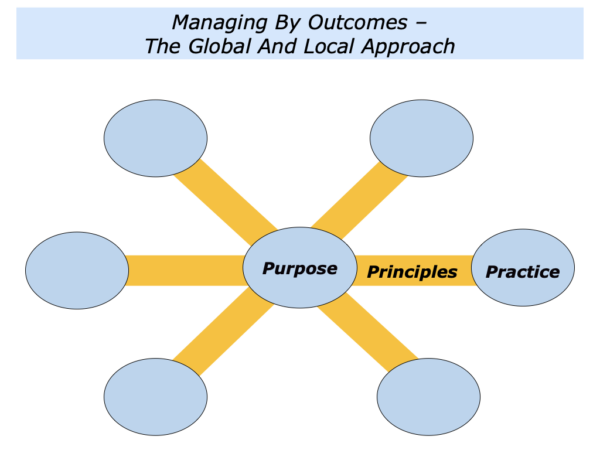
Good leaders sometimes want to feel more in control as they get older. At the same time, they want to encourage their people to take ownership for helping to deliver the goods. How to square this circle? Let’s explore one approach.
Good organisations manage by outcomes rather than by tasks. They also get the right balance between the global purpose and the local practice. They combine the best aspects of a big organisation with the spirit of a small enterprise.
The centre communicates the purpose and the principles. The way that people practice these is up to them, within parameters, in their part of the organisation.
But this comes with a proviso: people must show how what they are doing is following the principles and contributing to the purpose.
Good leaders encourage people to think global and act local. This calls for creating an adult-adult relationship, however, with everybody taking responsibility for making their best contributions to the company.
Imagine that you lead a large organisation and are addressing all the employees. You will aim to communicate the big picture whilst also encouraging people to take ownership for the local practice.
Different leaders will do this in different ways. One approach is to say something along the following lines to explain this approach to people.
Welcome To Today’s Session.
I am going to give an overview of our organisation’s purpose and the part you can play in making this happen.
Later I will give some examples of how people have contributed to this purpose in the past and how they can contribute in the future.
But first let me give an outline of our overall approach to working together.
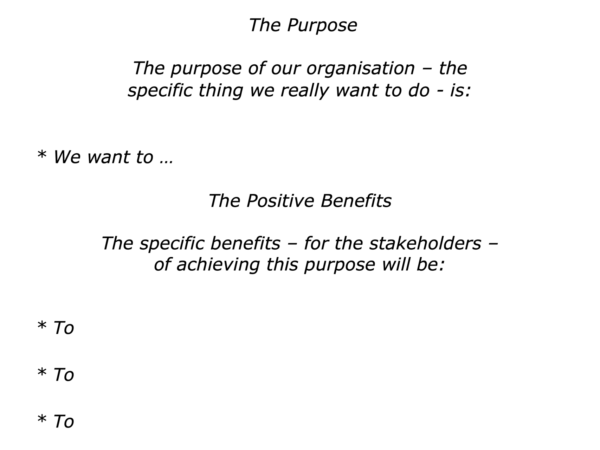
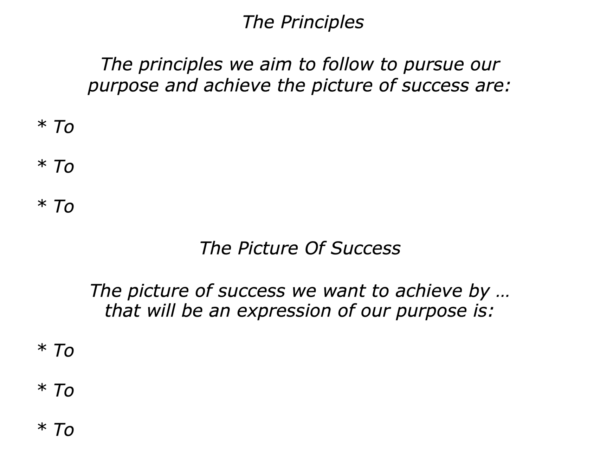
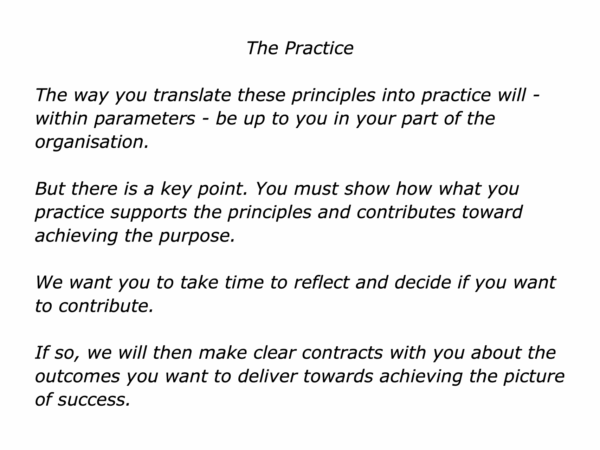
Good leaders build on the people who want to contribute. They then take the following step.
Managing By Outcomes
Good leaders give people the big picture because they recognise that knowledge workers, for example, want context. They then manage by outcomes rather than by tasks.
They spend a lot of time with people agreeing on what must be delivered. Many people are used to writing lists of tasks and talking about what they will do. It can take time to educate them to focus on the outcomes they will deliver.
Good leaders make crystal-clear contracts about the real results to achieve. Why? Because from then on virtually every performance conversation will start by concentrating on the agreed outcomes, rather than get into supervising the tasks.
After such a contracting session, for example, here is how one team leader might describe their contribution under the Three Ps.
My Contribution To The Picture of Success
Profitability
To ensure my team achieves its financial targets – a profit of £500k.
To develop 3 new customers and do work with them that delivers a profit of £100k.
To reduce our overheads by £100k.
Products
To ensure more than 90%+ of our customers say they are extremely satisfied with our work.
To develop 2 new products and pilot these successfully with customers – then launch these products by the end of the year.
To simplify 2 of our complex products to ensure these are more user friendly for customers – then get a further £100k’s worth of orders for these before the end of the year.
People
To deliver an internal morale rating of 90%+ of our team members saying they enjoy coming to work each day.
To educate, equip and enable 2 of my team members to win promotion and move on to other roles in the company.
To recruit 4 new positive team members who take responsibility, build on their strengths and get some early successes that contribute towards achieving the team’s goals.
Why take this approach? People can get into a pattern of talking about details, making excuses or whatever. They may also confuse activity with results.
Certainly sometimes it is vital to revisit the aims to ensure these are still desirable and possible. Whether it concerns profits, product quality or people, however, the mantra is:
“Let’s focus on the desired outcomes. How can we do our best to deliver these results?”
Sounds tough? Perhaps, but it is also a good way of leading a team. People learn:
To clarify the specific goals that are written in outcome terms;
To make clear contracts about the goals, including the required support;
To take responsibility, be creative and do their best to deliver the agreed outcomes.
Managing By Outcomes –
The Rule Of Three Approach
There are many ways to encourage people to focus on the outcomes to achieve. One of the simplest is the rule of three approach.
This involves communicating the three goals to achieve. If appropriate, each of these can be broken down into three sub goals. You can then aim to bring these to life with specific examples.
Some people follow the rule of three in their lives and work. They may do this when focusing on three goals, giving three messages to people or creating a model that has three steps.
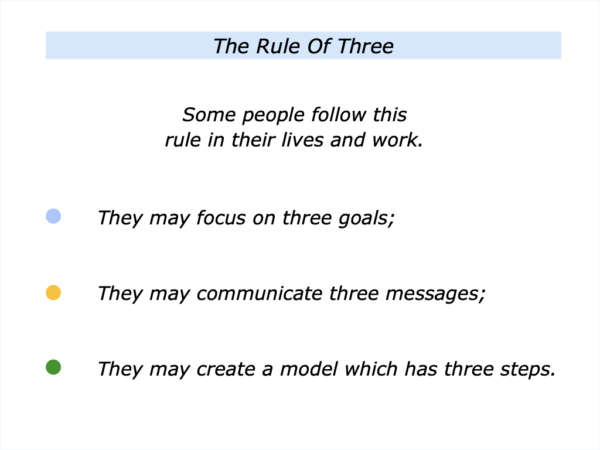
Why take this approach? People look for patterns to make sense of information. According to brain scientists, three is the easiest number for people to remember in terms of looking for patterns.
The Masterclass website gives some reasons when it can be useful to remember the rule of three. It describes this in terms of giving tips to writers but the rule often applies in other situations. Here is an excerpt from the website.
What Is The Rule Of Three?
The rule of three is a writing principle based on the idea that humans process information through pattern recognition. As the smallest number that allows us to recognize a pattern in a set, three can help us craft memorable phrases.
Good leaders sometimes communicate their team’s goals by following the rule of three. They may also add three points under each heading. This makes it easier to remember than a list of nine points. Different leaders do this in different ways. Here is one framework they use.
The Team’s Goals
The three key goals
we want to achieve are:
1) To …
For example:
To …
To …
To …
2) To …
For example:
To …
To …
To …
3) To …
For example:
To …
To …
To …
You will adapt the rule of three in your own way. Let’s look at another situation where it is important to manage by outcomes.
Managing By Outcomes
In Challenging Situations
Good leaders also focus on outcomes when people face challenges in their work. One leader I worked with took this approach when a team member asked them about how to deal with a problem client. The team member explained this in the following way.
“We are having problems with a difficult client. They are always complaining, even though we give good service, and this is wearing down our staff. The client is part of a culture where the bosses rule by fear, which may be why they take the same approach with us.
“The client now wants us to lower our prices. This will be difficult, however, because we make little money from our work with them. I also fear for our staff who are near breaking point. I would be grateful for any ideas you have about what we can do.”
The leader listened to their team member. They then said something along the following lines.
“Thanks for the background information. Of course, I am happy to offer some ideas. Before then, however, let’s look at the outcomes we want to achieve. Do we want:
“To keep the client – at least until we have found another to replace them; to keep giving good service and make some profit; to care for our staff and encourage them whilst we are trying to replace the client?
“Are there any other things we want to achieve? Bearing these things in mind, let’s explore the key things we can do to achieve these outcomes.”
The leader and team member agreed on a plan: a) to continue to give good service to the existing client; b) to find a new client to replace the income stream; c) to give support to their staff in the meantime. They translated their plans into action and resolved the issue within two months.
Many leaders find that over the years their control needs get stronger. They also realise, however, that they will be judged by the performance of their people.
How to make this happen? One approach is for them to manage by outcomes rather than by tasks. This can help them to build more self-managing and successful teams.
Let’s return to your own work. Looking ahead, can you think of a specific situation where you may want to follow elements of the managing by outcomes approach? How can you do this in your own way.
If you wish, try tackling the exercise on this theme. This invites you to complete the following sentences.
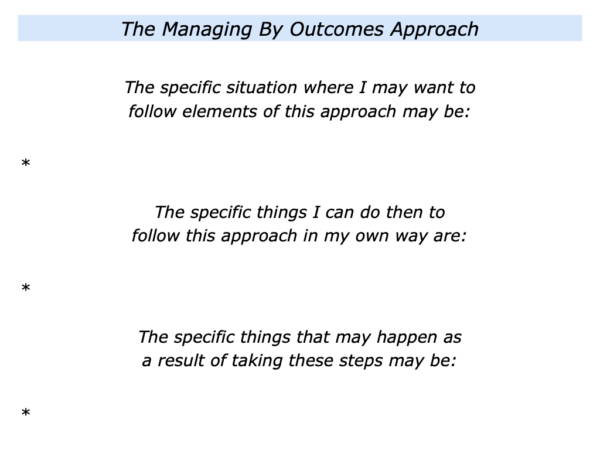


Leave a Reply